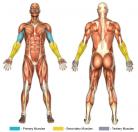Preacher Curls (Barbell)
- Adjust the seat of the preacher bench so that you can sit with your arms comfortably over the arm support pad.
- Stand behind the arm support, carefully lean over, grasp the barbell with an underhand grip (your palms will face upward and your thumbs will point outward), position your elbows on the arm support, and sit down. If you have trouble getting into position with the latter method, you may also lift the weight up prior to moving into position, and then position yourself as prescribed above. Lastly, a training partner or fellow gym patron can hand you the weight. Note: You may use a straight bar or an e-z curl bar.
- Curl the weight upward, exhaling throughout the movement.
- Lower the weight, inhaling throughout the movement.
- Repeat steps 3-4 for as many sets as are desired.
Doing preacher curls with a single dumbbell can allow for self-spotting, but doing so is not recommended due to the unfavorable position that preacher curls necessarily place the body in. Unlike standing curls, preacher curls are more cumbersome for self-spotting because they require that you really lean over the pad to reach under the dumbbell or your wrist to perform the spot. If you decided to perform a self-spot on preacher curls, use your free hand to gently help (via touch spot) the working arm to raise the weight when it becomes too difficult to lift unassisted.
By merely changing the way your forearm (and, consequently, hand) is positioned you can adjust which/(how the) muscles will be targeted, to at least some degree; this is done through pronation and supination of the forearm. Supination is the position of your forearm when your palm is facing outward/upward, and, conversely, pronation is when your palm is facing inward. Note that for most people anatomy will inhibit the forearm from pronating as far inward as it will allow the forearm to supinate outward.
So, to emphasize the biceps brachii, keep your forearm supinated (so that your thumb is pointed outward, i.e. your palm is facing outward/forward in respect to your body); to incorporate more brachioradialis, pronate your forearm (so that your thumb is pointed up, i.e. your palm is facing inward in respect to your body). In the case of curls, keeping the hand position neutral is the "hammer curl" variety of curls.
Some people may develop elbow (tendon) pain if they do curls incorrectly. Three things to remember to greatly reduce the chance of elbow injury are:
- Always control the weight, especially during the down movement. Letting the weight drop as the elbow reaches the bottom "locked" position causes tremendous stress on it that will eventually likely result in injury. This effect is especially robust with preacher curls, as the pad lies beneath your elbow(s) thus creating even more stress on them than if they merely had gravity working against them.
- Keep your wrists straight (neutral). It is in this manner that maximum biceps stress will be achieved. Bending your wrist in either direction (upward or downward) removes focus from the intended muscle, the biceps, and creates vulnerability to injury (elbow or wrist).





